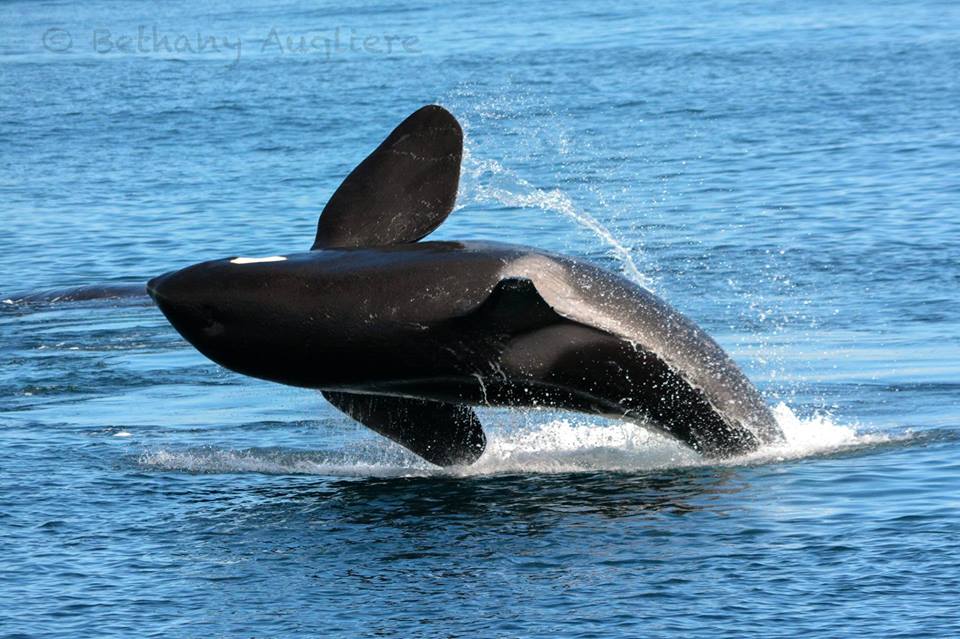
People travel from all over the world to snorkel and dive with the charismatic dolphins of the Bahamas, like the the playful spotted dolphins or aloof bottlenose. They’re pretty well-known marine mammals for the area. But, there’s another dolphin that cruises the waters of the Bahamas, and is far more elusive and rare — the orca.
Orcas are the largest oceanic dolphin species in the world, and are found in every ocean in the world. “They are the most widely distributed of all cetaceans (whales and dolphins). Scientific studies have revealed many different populations with several distinct ecotypes (or forms) of killer whales worldwide—some of which may be different species or subspecies,” according to NOAA Fisheries.
In the Pacific Northwest of the US, for instance, some ecotypes eat only salmon, while others eat mammals, like harbor porpoises and seals. In Punta Norte of Argentina, orcas strand themselves on the beaches to eat Southern sea lion pups. In Norway and Iceland, they feed on herring. And in the Gulf of California, stingrays are a common dinner item for orcas. These top predators are adaptable and flexible.
Orcas in the Bahamas
Yet, little is known about orcas of the Caribbean and Tropical Atlantic In the Bahamas, although killer whale sightings have been documented from as early as 1913, only one published record exists since that initial published account, according to a study by Charlotte Dunn and Diane Claridge of the Bahamas Marine Mammal Research Organization.
In a 2013 study, the biologists compiled 34 sightings of killer whales in the Bahamas, recorded from 1913 to 2011. They found that group sizes were generally small averaging around 4 individuals, but up to 12.
According to the study, 13 sightings were documented with photographs and/or video of sufficient quality to allow individual photo-identification analysis. Of the 45 whales photographed, 14 unique individual killer whales were identified, eight of which were re-sighted between two and nine times. An adult female (Oo6) and a now-adult male (Oo4), were first seen together in 1995, and have been re-sighted together eight times over a 16-yr period.
In the Bahamas, it seems they dine on slightly different prey items. The scientists reported that they’ve only been observed preying on marine mammals, including Atlantic spotted dolphin (Stenella frontalis), Fraser’s dolphin (Lagenodelphis hosei), pygmy sperm whale (Kogia breviceps) and dwarf sperm whale (Kogia sima), all of which are previously unrecorded prey species for killer whales. In 2005, BMMRO scientists observed and photographed a killer whale with a dwarf sperm whale in its mouth.
Learning More
In fact, at times, entire female family units of spotted dolphins have gone missing from our study site never to be seen again. Denise Herzing, PhD, our founder and director, has wondered if could be a pod of orcas traveling through the region and predating on the family group.
There’s certainly more to learn about orcas in the Bahamas, including their movement patterns, population structure and abundance. It’s just a question of finding them and finding them and the means to do so. It’s certainly no easy feat.
So far, we’ve never seen orcas while surveying for dolphins at our two study sites, but we always keep an eye out, as we’ve seen other species like sperm whales, pilot whales, pantropical spotteds, false killer whales and risso’s dolphins. Maybe one day we’ll get an orca sighting….
Further Reading:
Scientific Study by BMMRO: Killer Whale (Orcinus orca) occurrence and predation in the Bahamas.
Our former blog about other marine mammal sightings in the Bahamas and our scientific paper: “More than Spotted Dolphins”
